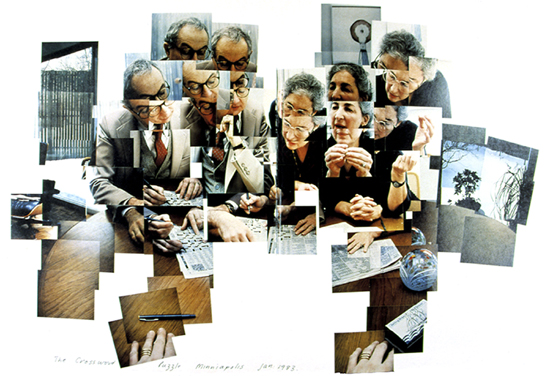David Hockney has been hailed as the greatest British painter alive, and perhaps only a few would like to disagree. The reason I am writing about Hockney is in part because he is one of the few artists who have appreciated the role of technology in the advancement of art, and used the latest offerings of science to create truly modern works.
Hockney was already a rising star in Britain when he chose to move to Los Angeles because (by his own admission) he liked both the weather and liberal environment of California. He rose to fame in the 1960s (along with artists like Andy Warhol and Roy Lichtenstein) when the Pop Art movement was at its peak. One of Hockney's most famous paintings from this time, "A Bigger Splash" (seen below), is a playful and masterly composition in which rectilinear shapes (horizontal lines of the house and the pool edge, and the vertical lines of the trees) are only interrupted by the the oblique lines of the chair and the diving board, harmoniously echoing the way in which a splash left by an unseen diver interrupts the quietness of the surrounding scenery. It is also worth noting how the splash is crucial in providing the 3D effect in an otherwise remarkably (and deliberately) flat painting. This playfulness is very characteristic of Hockney's art.
But Hockney is an inventor, for he keeps reinventing himself in different mediums. His deep admiration for photography has led him to adapt it as an integral technology used to create his compositions. However he has not fully satisfied with video recordings because he felt that any recording was limiting the viewer's ability to wander about in the composition by imposing a linear timeline on the sequence of photos that form the video. Instead he advocated "photo collage" or "joiners" as a better means of capturing and highlighting the aspects that the painter wants the viewer to notice. Seen here is an example of Hockney's photo collage of Minneapolis Walker Art Center's director and his wife solving crossword puzzles. It captures the entire process of thinking, wondering, and the excitement of the "Aha!" moments as they solve the puzzles together. For more information about his "Joiners", watch Hockney's interview on YouTube.
Joiner: Martin Friedman and his wife solving a crossword puzzle
Hockney also explored this idea of capturing a sequence of events in his paintings after he came across Chinese scroll paintings, which depicted scenes temporally as opposed to a single snapshot or a single point of view. This led him to paint a series of pictures of the road that he took and the surrounding landscapes on his way to a hospital to meet a friend (see below). What Hockney was trying to capture in this series was the essence of the journey itself - the process rather than the end.
An unrelenting innovator, an aged Hockney took up plein-air painting ("in the open") in 2006 when he returned to his native Yorkshire and created a series of fascinating landscapes in huge panels for the "A Bigger Picture" exhibition at the Guggenheim Museum in Bilbao. Hockney went back to using the photography and the latest digital technologies to align and superimpose the canvas paintings to create the large panels (seen below).
A Bigger Picture
But what is most impressive about this extraordinary man is that he has moved onto a new medium -one which only the techno-buffs will become the early adopters of, or so you would think. This new medium is the iPad. Hockney, the innovator, is now creating his paintings on the iPad, and he recently had a successful exhibition in CA. Some of his paintings on the iPad can be seen below. You can also read more about Hockney's iPad paintings (wired.com). Hockney has opined that this technology which is poised to usher in a new wave of creativity is now in the hands of everyone, it's a new medium of self-expression -one that is accessible to all, even those without any formal academic training in art schools. Technology is once again advancing the arts and democratizing it for the masses to appreciate, much like the way the Renaissance painters brought art closer to masses. As Contemporary art continues to become ever more esoteric and idiosyncratic, trapped in the art galleries, cut off from the ordinary people, this is perhaps a very sobering voice of reason.
It is Hockney's fascination with not just painting, but the process as well, including the role of technologies in shaping art, that makes Hockney stand out. In 2000, Hockney and physicist Charles Falco proposed a controversial theory (and some evidence) that art historians had not fully grasped till then. Hockney argued that Renaissance masters like Jan van Eyck, Lorenzo Lotto, and Vermeer were using concave mirrors to make their paintings realistic. In essence even before the advent of modern day photography and lenses, Renaissance painters had begun to use the basic principles of optics to make photorealistic paintings. Hockney argued that Arab scholar Ibn Al-Hytham's "Book of Optics" was the source for the Renaissance painters discovery of the technology, which resulted in a sudden improvement in their ability to paint realistic portraits and images in early 1400s. His theory has opened a new discussion on the history of science and what role it played in the advancement of Renaissance aesthetics. To learn more about this theory, watch Charlie Rose's interview of David Hockney about Camera Obsura.
It is Hockney's ability to bridge the worlds of science and arts that makes him an important figure in today's world. One without the other would be a much poorer world to live in. Hockney understands that and explore this interdependency to inform us of the past and open our eyes to imagine future possibilities.









No comments:
Post a Comment